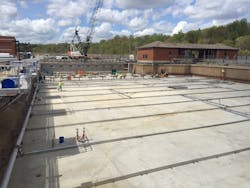Meurer Research, Inc.’s Inclined Plate Settlers and Hoseless Cable-Vac Sludge Collectors are being installed to replace aging equipment, improve effluent quality and enhance solids removal at the Richmond, Va., Water Treatment Plant. The MRI system is designed for a maximum peak flow of 140 million gpd.
To retrofit the four sedimentation basins, MRI equipment is being installed in one basin per year over a four-year period. The phased approach enables the city of Richmond plant—one of the largest water producers in Virginia—to be upgraded without interrupting operations.
Retrofitting of the second basin will be completed this year.
MRI, an engineering and manufacturing company, designed and built the plate settlers and sludge collectors to meet site specifications of engineering firm Whitman, Requardt & Associates, LLP.
Situated along the James River, the 230-ft basins are slightly curved and longer than typical sedimentation basins. In addition, the basin depths are five ft shallower than normal and installation access is limited. The unique shape and installation challenge required a highly customized design.
“We did all of the design work upfront in order to facilitate installation planning and budgeting. Discussions about upgrading the plant began five or six years ago and the equipment design was central to the project. We were glad to be instrumental in the planning,” said Joe Brauch of Meurer Research, Inc.
Each of the basins is being retrofitted with 3,150 Inclined Plate Settlers and nine Hoseless Cable-Vac Sludge Collectors for a maximum peak flow of 35 mgd, or 140 mgd total for the four basins.
“Normally, the sludge collector travels in the direction of the water flow. To accommodate the curvature and long length of the basin, we are running the sludge collectors across the width of the basin instead,” said Brauch.
The layout enables plant operators to run the sludge collectors at the front end of the basin more often where heavier and more solids settle.
MRI also provided the stainless steel walkways and effluent troughs for each basin. The new system is designed for future expansion with the capacity to treat an additional 12 mgd per basin.
Installation in the first basin was completed in 2015. Preparation for installation in the second basin is underway with the full install slated to be completed this year. The final two basins will be completed in 2017 and 2018 respectively.
Source: Meurer Research, Inc.


